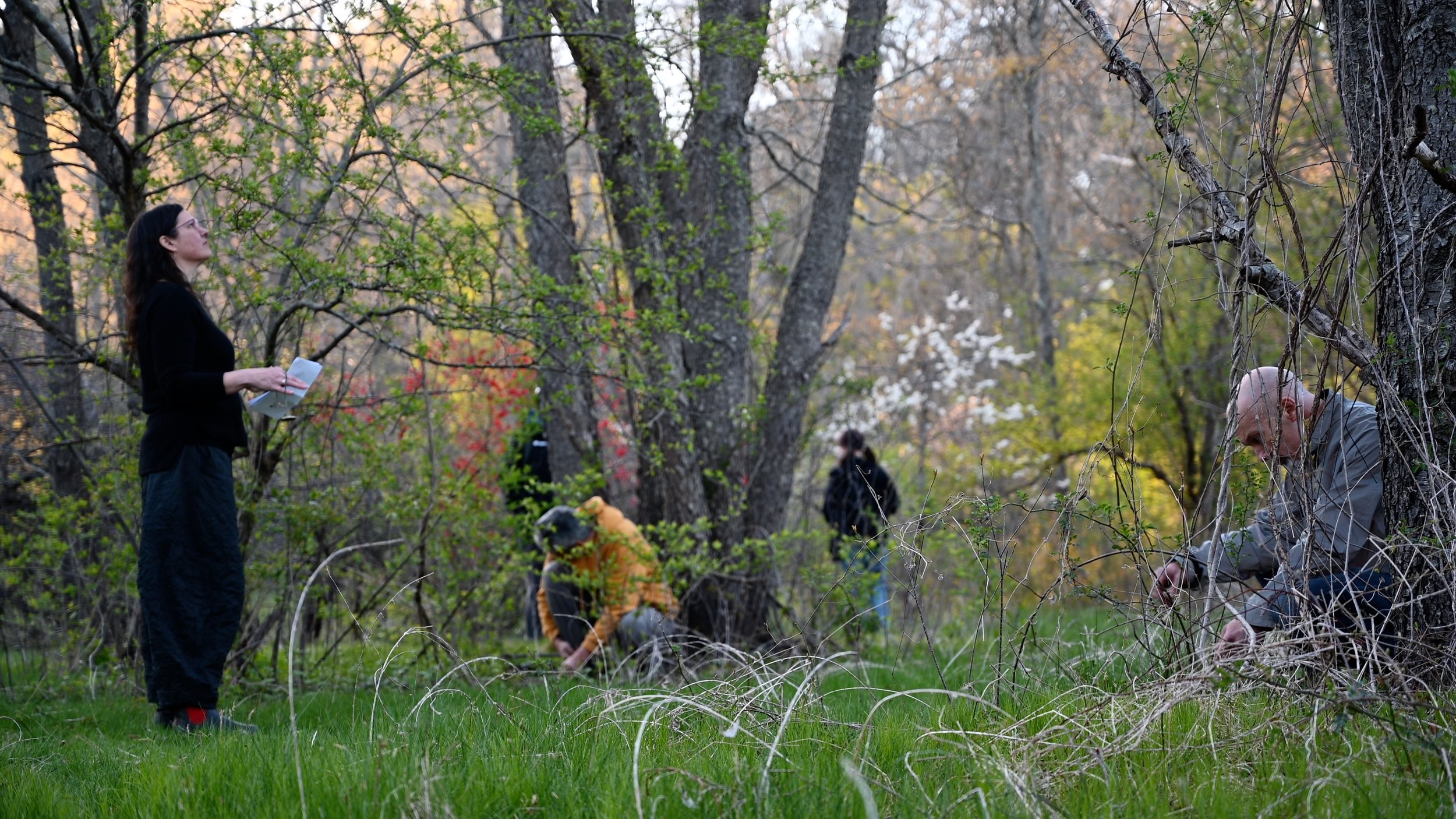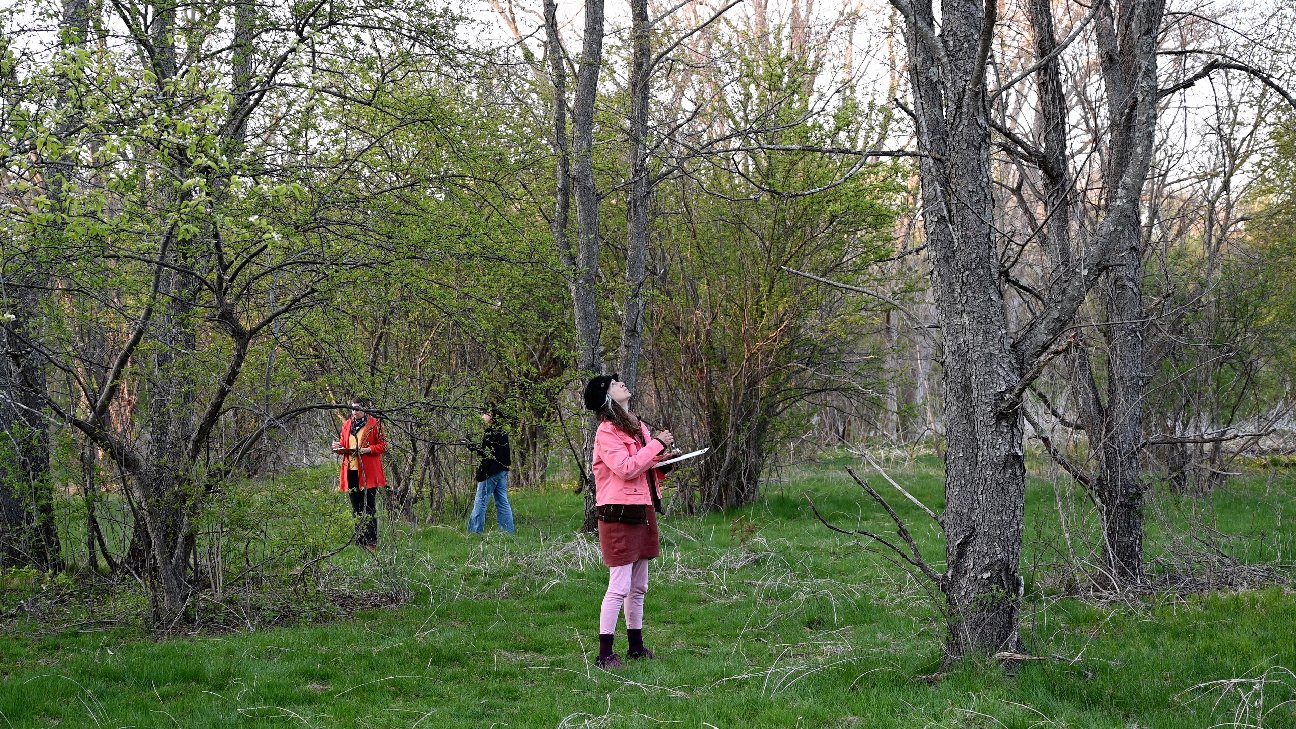
Urban Tree Oracle: Black Cherry, kin
Tree: Black Cherry
Aspect: kin
Season: spring
Sense: movement, touch
The Urban Tree Oracle: Black Cherry gathering took place in a grove of Black Cherries at Bussey Brook Meadow, an urban wild that is part of Boston’s Arnold Arboretum, on a spring evening in May 2024. The event was part of Boston’s Arbor Week, organized by the community organization Speak for the Trees, who works together with Boston community members to plant, preserve, care, and advocate for trees and to expand the tree canopy in order to rebuild resilient neighborhoods and safeguard the health of all residents, repairing historic injustices that persist today as environmental inequities in urban communities.
Participants introduced themselves to Black Cherry and performed the movement and touch-based score in and amongst the grasses, insects, birds, and many beings in the grove. Then, together, we sat and created our oracle cards silently, drawing and writing words that evoke and reflect upon the experience of kinship with the more-than-human.
Score for Black Cherry
You are an antenna
attuned through your senses
to the ecology you are within.
Create lines of connection
from kin to kin to kin.
Black Cherry
Prunus serotina
Notice Black Cherry in your daily travels when you see their long, drooping, fragrant spring flowers or their distinctive reddish smooth wood in fine furniture or the bark of older trees which resembles burnt potato chips or, on younger trees, shiny with wide horizontal lines or lenticels, though which Black Cherry exchanges breath with all around them. Its often one of the first trees to enter a disturbed area, making it a marker of transformation, letting us know the history of a place by its very presence. Black Cherry is spread by birds, which also makes evident to us their avian highways. Shade intolerant, drought tolerant, fast growing, frost susceptible, and native to Eastern North America, Black Cherry is a beloved friend, neighbor, and community member.
Black Cherry shares lavishly with a dizzying range of beings in their neighborhood. Scientists call them a keystone species, a term that describes their outsize effect on the abundance and diversity of other species. Their fruit is eaten by many mammals, including black bears, wild turkeys, Spotted Skunks, Eastern Gray Fox, and even Eastern Box Turtles. Song, passerine, and game birds such as American Robins, Northern Cardinals, Hermit Thrush, Song Sparrows, and European Starlings thrive on the highly nutritious fruits and in exchange for their dinner, they disperse the seeds widely. Hundreds of insects rely on Black Cherry for food and, in some cases, shelter, such as ants, native beetles, spiders, wasps, finger galls. These insects become unsuspecting pollination partners, as they transport some of the pollen from Black Cherry’s long drooping flowers to other Black Cherries. Over 456 species of butterflies and moths feed on the leaves of Black Cherry when they are caterpillars. This dazzling complexity of relationships enhances and preserves the entire ecosystem. Every being is kin to each other and without these connections the entire web of life diminishes. Black Cherry models for us a generous and generative care and support for the great “assembly of beings” as Gary Snyder called it.

We become kin when we share gifts and can help each other out, just like members of our human family.
Robin Wall Kimmerer






Tree Oracle on a Perfect Spring Evening. a reflection by Nathan Phillips
After we found kinship among the trees through the embodiment exercise, we sat in collective artmaking, using black cherry ink prepared from the bark of those very trees, to draw. Our open-ended drawing prompt was simply a small cherry bark imprint from the same trees we sat among, using their own ink, and the ink-stamped words “kin” and “black cherry” on paper.
Like staring at clouds or a Rorschach image, we were each given one of an infinity of unique imprints with an infinity of possible interpretations, but the mind typically quickly sees something. I saw the torso of a human, myself, walking toward me with the backdrop of a steep rocky cliff behind me and to my right. I envisioned an exact location, an I95 off-ramp shoulder in Newton, MA. A beautiful, loud but lonely, desecrated place.
The bark imprint grounded me in a distant but familiar place and gave me a toehold from which I began to draw. The rocky cliff presented the sharp angles and crystalline fractal faces and cuts of rock, with more curvaceous vines and trees crawling over or jutting out from nooks and crannies in and above the cliff face. The word “interconnection” came to me and I began to draw a combination of unbounded fractal networks and bounded fractals. Asymmetry came naturally in my drawing, from the sharply angular tree structure of young pines, to the highly sinuous and meandering network of vines or rivers. I connected the angular network with the sinuous one through a dotted connector which ran through the bark imprint “cliff”. This was an impulse to both connect tree, rock, and river and recognize their distinct existence.
Urban Tree Oracle: Black Cherry zine
36 pages, stapled, 6” x 9”
available as part of the Urban Tree Oracle zine subscription, sign up via my substack newsletter at the tk level to get a monthly zine from the project, or just get this one zine



